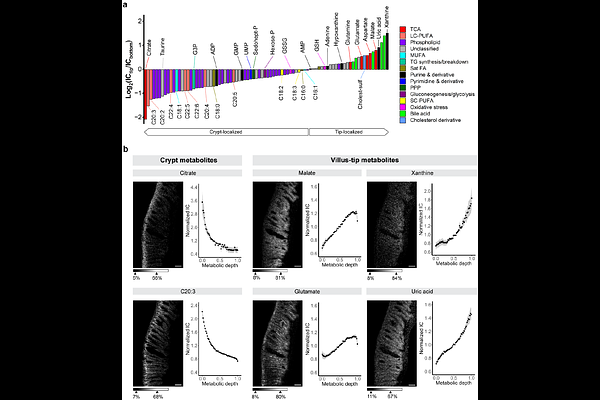Spatial metabolic gradients in the liver and small intestine

Spatial metabolic gradients in the liver and small intestine
Samarah, L. Z.; Zheng, C.; Xing, X.; Lee, W. D.; Afriat, A.; Chitra, U.; MacArthur, M.; Lu, W.; Jankowski, C. S. R.; Ma, C.; Hunter, C. J.; Raphael, B. J.; Rabinowitz, J. D.
AbstractMammalian organs are composed of cells, whose properties differ depending upon their spatial location. Gene expression in liver varies between periportal and pericentral hepatocytes, and in intestine from crypts to villus tips. A key element of tissue spatial organization is likely metabolic, but direct assessments of spatial metabolism remain limited. Here we map spatial metabolic gradients in murine liver and intestine. We developed an integrated experimental-computational workflow using MALDI imaging mass spectrometry, isotope tracing, and deep learning artificial intelligence. Most measured metabolites (> 95%) showed significant spatial concentration gradients in liver lobules and intestinal villi. In the liver, tricarboxylic acid (TCA) cycle metabolites and their labeling from both glutamine and lactate localized periportally. Energy-stress metabolites including adenosine monophosphate (AMP) also localized periportally, consistent with high periportal energy demand. In intestine, the TCA intermediates malate (tip) and citrate (crypt) showed opposite spatial patterns, which aligned with higher glutamine catabolism in tips and lactate oxidation in crypts based on isotope tracing. Finally, we mapped the fate of the obesogenic dietary sugar fructose. In the intestine, oral fructose was catabolized faster in the villus bottom than the tips. In the liver, fructose-derived carbon accumulated pericentrally as fructose-1-phosphate and triggered pericentral adenosine triphosphate (ATP) depletion. Thus, we both provide foundational knowledge regarding intestine and liver metabolic organization and identify fructose-induced focal derangements in liver metabolism.